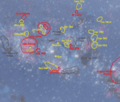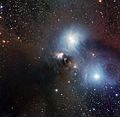Corona Australis facts for kids
| Constellation | |

List of stars in Corona Australis
|
|
| Abbreviation | CrA |
|---|---|
| Genitive |
|
| Pronunciation | or genitive |
| Symbolism | The Southern Crown |
| Right ascension | 17h 58m 30.1113s–19h 19m 04.7136s |
| Declination | -36.7785645°–-45.5163460° |
| Area | 128 sq. deg. (80th) |
| Main stars | 6 |
| Bayer/Flamsteed stars |
14 |
| Stars with planets | 2 |
| Stars brighter than 3.00m | 0 |
| Stars within 10.00 pc (32.62 ly) | 0 |
| Brightest star | α CrA (4.10m) |
| Messier objects | 0 |
| Meteor showers | Corona Australids |
| Bordering constellations |
|
| Visible at latitudes between +40° and −90°. Best visible at 21:00 (9 p.m.) during the month of August. |
|
Corona Australis, also known as Corona Austrina, is a constellation you can see in the night sky. Its name means "southern crown". It is like a partner to Corona Borealis, which is the northern crown.
An ancient astronomer named Ptolemy first listed Corona Australis in the 2nd century. It is still one of the 88 constellations we recognize today. The Ancient Greeks thought it looked more like a wreath than a crown. They often linked it to the constellations Sagittarius or Centaurus.
The two brightest stars in Corona Australis are Alpha and Beta Coronae Australis. They shine with a brightness of about 4.1 magnitude. Even though it's not super bright, this constellation has a unique shape. It also contains one of the closest places where new stars are forming!
Contents
What Makes Corona Australis Special?
Corona Australis is a small constellation. It is next to Sagittarius in the north and Scorpius in the west. To its south is Telescopium, and to the southwest is Ara.
The official short name for this constellation is 'CrA'. This abbreviation was chosen by the International Astronomical Union in 1922. You can't see Corona Australis from places like the United Kingdom. This is because it is too far south. But you can spot it from southern Europe and the southern United States.
Stars and Objects in Corona Australis
Even though Corona Australis isn't very bright, its stars form a clear pattern. This makes it easy to find.
Double Stars
Some of the interesting stars here are actually double stars. This means they are two stars orbiting each other.
- Gamma Coronae Australis is a pair of yellowish-white stars. They are about 58 light years away from us. These two stars complete an orbit around each other every 122 years.
Variable Stars and Nebulae
R Coronae Australis is a special type of star called an irregular variable star. This means its brightness changes over time. It is a blue-white star and is very young. It is still gathering gas and dust from space.
This young star is hidden by a cloud of gas and dust called a nebula. This nebula is named NGC 6729. The star's light makes the nebula glow. As the star brightens and dims, so does the nebula around it.
NGC 6729, along with NGC 6726, NGC 6727, and IC 4812, form the Corona Australis Nebula. This is a dark, dusty cloud where new stars are actively being born. It contains Herbig–Haro objects, which are like baby stars still growing. This nebula is about 430 light years away. It is one of the closest star-forming regions to our own Solar System.
Star Clusters
NGC 6541 is a globular cluster. This is a large, round group of thousands of stars. It looks like a fuzzy ball through binoculars. It is about 7th magnitude in brightness. This cluster is very far away, about 22,000 light years from Earth.
Neutron Stars
Corona Australis is also home to RX J1856.5-3754. This is an isolated neutron star. Neutron stars are super dense objects left over after a giant star explodes. This one is one of the closest to Earth, about 200 light years away. Scientists think it might even be a rare type called a strange star.
Images for kids
-
A star chart of the night sky towards the center of our galaxy. The Corona Australis Molecular Cloud is marked in green at the bottom left.
-
A close-up view of the Orion Arm of our galaxy. Major star groups (yellow), glowing nebulae (red), and dark nebulae (grey) are shown around the Local Bubble. The Corona Australis Molecular Cloud is marked below the middle.
-
Corona Australis as it was drawn in the Atlas Coelestis by John Flamsteed.
See also
 In Spanish: Corona Australis para niños
In Spanish: Corona Australis para niños







